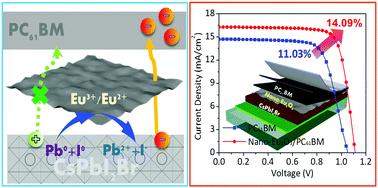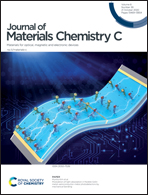Redox-active Eu2O3 nanoflakes as a buffer layer for inverted CsPbI2Br perovskite solar cells with enhanced performance†
Abstract
Solution processed CsPbX3 films usually present a high content of Pb0 clusters, acting as significant defects on the perovskite surface. Conventional electron transport materials, including PC61BM, TiO2, ZnO, SnO2 and Nb2O5, can hardly passivate these defects. In this work, few-layered Eu2O3 nanoflakes (nano-Eu2O3) are prepared, which exhibit much higher redox activity towards Pb0/I0 than the commercial Eu2O3 powder. When nano-Eu2O3 is introduced as the buffer layer between the CsPbI2Br and PC61BM layers in inverted perovskite solar cells (PeSC), the devices deliver remarkably improved photovoltaic performance with an average power conversion efficiency (PCE) of 13.47% and a champion PCE of 14.09%, which is much superior to the control devices without nano-Eu2O3 (9.74/11.03%). A series of mechanism studies reveal that the addition of nano-Eu2O3 buffer layer enables not only more efficient hole-blocking but also remarkably enhanced defect passivation at the perovskite/PC61BM interface, both of which result in significantly reduced interfacial charge recombination. Besides, we show that the devices with nano-Eu2O3 exhibit obviously improved thermal stability with >90% PCE remaining after 400 h of thermal aging at 80 °C.



 Please wait while we load your content...
Please wait while we load your content...